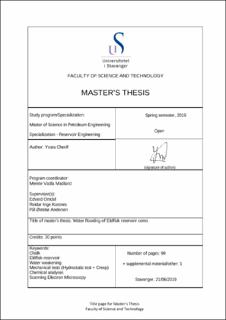| dc.contributor.advisor | Omdal, Edvard | |
| dc.contributor.advisor | Korsnes, Reidar Inge | |
| dc.contributor.advisor | Andersen, Pål Østebø | |
| dc.contributor.author | Cherif, Yosra | |
| dc.date.accessioned | 2020-03-26T09:20:23Z | |
| dc.date.available | 2020-03-26T09:20:23Z | |
| dc.date.issued | 2019-06 | |
| dc.identifier.uri | https://hdl.handle.net/11250/2648778 | |
| dc.description | Master's thesis in Petroleum engineering | en_US |
| dc.description.abstract | Enhanced Oil Recovery (EOR) and the effect of the aqueous chemistry on the mechanical strength of chalk have been extensively studied over the years. This is simply because the stability of the reservoir system is affected by several interdependent factors such as the mineralogical composition, temperature, pressure, and brine ionic composition. For instance, seawater injection in North Sea chalk reservoirs has the ability to decrease the mechanical properties of the reservoir rocks, known as water weakening. This phenomenon leads to compaction which is on one side a significant method for Improved Oil Recovery (IOR) but is on the other side a cause of seabed subsidence. Then, in order to study and separate the effect of specific ions, seawater has been substituted by brines with simpler aqueous chemistry, like NaCl, MgCl2 and MgCl2 combined with CaCl2.
A vast amount of research have been conducted on outcrop chalks to predict the properties of reservoir chalk when exposed to different EOR brines. This is because onshore chalk analogues to that of the North Sea are easily obtainable and less expensive to sample. However, in this study the geo-mechanical behaviour of chalk is investigated by performing a series of preliminary tests on real reservoir chalk sampled from the North Sea. Then, the obtained results are compared with previous test results gained from outcrop chalks.
The mechanical behaviour and the phenomenon known as water weakening of chalk is studied by flooding cores under isotropic stress at 130°C with nonreactive brines such as NaCl and reactive brines like synthetic seawater (SSW), MgCl2, and MgCl2 combined with CaCl2. Chemical- and microscopic analysis were also employed to further investigate the compositional variation of fluids and mineralogical alteration of chalk, and hence study the interplay between chalk and injected fluids referred to as water weakening.
Experimental results show that the chemical effect of 0.219 M MgCl2 or SSW injection into reservoir cores have a significant influence on the mechanical behaviour compared to that observed with 0.657 M NaCl brine. This was clearly noticed from the creep development when changing brines from NaCl to MgCl2 in the first test and to SSW in the second test. These results are in agreement with previous work performed on outcrops. The creep compaction in core flooding experiments was explained by precipitation of secondary Mg-bearing minerals and dissolution of primary calcite. | en_US |
| dc.language.iso | eng | en_US |
| dc.publisher | University of Stavanger | en_US |
| dc.relation.ispartofseries | Masteroppgave/UIS-TN-IEP/2019; | |
| dc.rights | Navngivelse 4.0 Internasjonal | * |
| dc.rights.uri | http://creativecommons.org/licenses/by/4.0/deed.no | * |
| dc.subject | petroleumsteknologi | en_US |
| dc.subject | petroleum engineering | en_US |
| dc.subject | reservoarteknologi | en_US |
| dc.subject | chalk | en_US |
| dc.subject | Eldfisk | en_US |
| dc.title | Water flooding of Eldfisk reservoir cores | en_US |
| dc.type | Master thesis | en_US |
| dc.subject.nsi | VDP::Technology: 500::Rock and petroleum disciplines: 510::Petroleum engineering: 512 | en_US |

